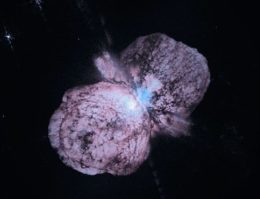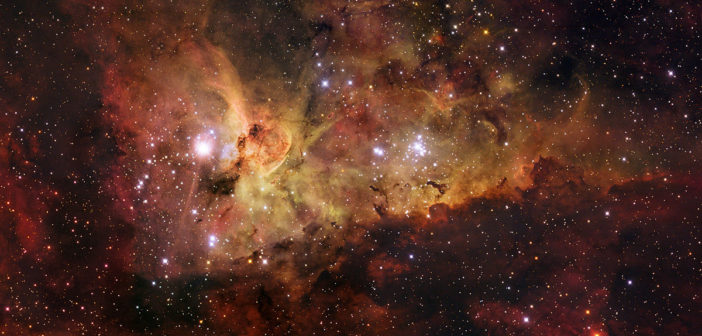
Hubble view of the Homunculus Nebula surrounding Eta Carinae [NASA Hubble Space Telescope/Jon Morse (University of Colorado)]
Dramatic Target
The massive evolved star Eta Carinae, located ~7,500 light-years away in the constellation Carina, is the most luminous star in the Milky Way. Eta Carinae has a quite a reputation for drama: it has been very unstable in the past, exhibiting repeated eruptions that have created the spectacular Homunculus Nebula surrounding it. Its present-day wind has the highest mass-loss rate of any hot star we’ve observed.
Picture of Stellar Wind

Top panel: February 2017 observations of Eta Carinae in continuum (left) and H-alpha. Middle panel: the normalized radial profile for H-alpha and continuum emission. Bottom panel: the full width at half maximum for H-alpha and continuum emission of Eta Carinae. The H-alpha is about 2.5 to 3 milliarcseconds wider than the continuum. [Adapted from Wu et al. 2017]
This nicely testable hypothesis is rendered less convenient by the fact that it’s hard to get resolved images of Eta Carinae’s H-alpha emission. Its distance from us — and the fact that it’s shrouded in the complex nebula it created — have thus far prevented us from resolving the H-alpha emission from this star. Now, however, a team of scientists from Steward Observatory, University of Arizona have changed this.
Confirming the Model
Led by Ya-Lin Wu, the team obtained diffraction-limited images of Eta Carinae using the Magellan adaptive optics system. The observations, made in both H-alpha and continuum, show that the H-alpha emitting region is significantly wider than the continuum emitting region, as predicted by the model. In fact, the measured emission implies that the H-alpha line-forming region may have a characteristic emitting radius of ~25–30 AU — in very good agreement with the Hillier et al. stellar-wind model.
This confirmation is strong support of the physical wind parameters estimated for Eta Carinae in the model, like the mass-loss rate of 10^-3 solar masses per year. These parameters are enormously helpful as we attempt to understand the physics of strong stellar-wind mass loss and the late evolutionary phases of very massive stars.
Citation
Ya-Lin Wu et al 2017 ApJL 841 L7. doi:10.3847/2041-8213/aa70ed

3 Comments
Pingback: can't get enough of eta Carinae
Pingback: Astronomia: fortissimi venti stellari, Eta Carinae oggetto di studio - Meteo Web
Pingback: Un modello per Eta Carinae – La Macchina del Tempo